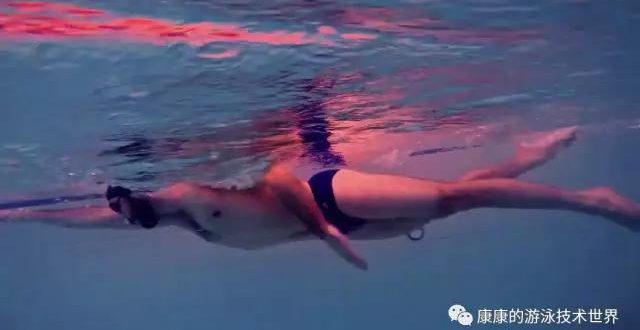自由泳期间的呼吸是一件有趣的事情。当你擅长时,很难明确说明它为什么起作用 – 它就是这样。当你不在的时候,这就是你所想的,这使得游泳思维麻木起来难以启动。
考虑到这一点:在自由泳的一个周期内,游泳运动员需要在两次击球的范围内精确完成15个不同的运动。尽管大多数运动员都在多任务处理,但在很短的时间内仍然是一系列非常复杂的动作。
运动的这种复杂性会导致游泳者呼吸和游泳的方式出现很多不同类型的问题。我们与SwimLabs的铁人三项运动员一起工作的最常见问题之一是通过滚动他们身体呼吸的游泳运动员。在游泳世界中,这被称为“过度旋转”或“不平衡”的呼吸。
呼吸过度旋转有一个巨大的障碍:人体不能漂浮在这个位置。下一次你去游泳池,试试这个小实验,看看为什么:在你的身体上浮动,头部处于呼吸状态。最有可能的是,这会使你很快下沉,就像你在呼吸时过度旋转一样。这使得在游泳中始终如一地使用好技术变得更加困难。
解决这个问题需要了解一些关于游泳自由泳时身体旋转的工作方式。在游泳世界中,自由泳被称为“长轴”中风,这意味着当他们的手臂在水中冲击时,游泳者的身体沿着脊柱的线从一侧到另一侧旋转。通常,大多数游泳运动员相对于表面在20至45度之间旋转。还有一条通用的经验法则,即如果游泳者旋转超过45度,则会下沉。
保持呼吸中的平衡关乎一致性。理想情况下,呼吸和无呼吸行程时的旋转角度应该完全相同。这使你更容易保持身体在水中的平衡。这将帮助你减少你的中风数量,从而导致更高效(通常更快)的游泳。
要做到这一点,需要做以下两件事:1.您需要在中风早期开始呼吸运动,并且2.您需要确保您的身体永远不会在水中旋转超过45度。
我不知道你的情况,但我不会把量角器带到水池里,即使我这样做了,我也不知道在游泳时如何测量自转。幸运的是,对我来说,知道自己旋转得多么重要,因为它知道我不会旋转到很远,而“肚子钻”是一个很棒的练习,可以提供精确的信息。
肚脐钻被设计为做两件事:1.它允许游泳者“感觉”早期呼吸启动感觉是什么样的,并且2.它使呼吸期间过度旋转非常困难。这两件事使它成为在平衡呼吸时使用的完美演习。
肚子钻可能是您学习过的最简单的练习之一。双臂伸展在你面前,从“超人”的位置开始。保持一只手臂在那个位置,并将你的手抚摸到你的肚子。当你抬头呼吸时将它留在原地。一旦完成,完成该手臂的抚摸动作,并开始用另一只手臂抚摸。在进行此练习时,最好在呼吸之间进行平均数量的运动,以便尽可能保持运动一致。
肚子钻套装
注意:在SwimLabs中,我们使用这个更长的集合与很多我们的客户。做这种设置可以确保你能够在比赛日保持这种长距离的呼吸。
重点:这次演习的重点是保持呼吸时的平衡,并且正确地协调你的呼吸。
2×100自由式肚子钻:呼吸x 4(休息10或15秒)
2×200自由式呼吸x 4(休息15秒);保持平衡的呼吸
事实上,无论你尝试多么努力,除非你呼吸正常,否则你不能游泳自由泳,并且在自由泳中适当地呼吸是困难的。如果你花一些时间学习如何在呼吸中保持平衡,那么你会很好地沿着优化你的呼吸方式,以便在比赛当天能够更快地游泳。
需要让它更容易?
站在底部并拿着水槽时,尝试相同的呼吸模式。
当你游泳的时候,在头上重复一个模式,比如“肚子,呼吸,1,2,3,4”,这样可以更容易地确保你完成每次动作。
不要急于!如果游泳速度较慢,则进行演练会更容易。
Breathing during freestyle is a funny thing. When you are good at it, it’s hard to articulate exactly why it works—it just does. When you’re not, it’s all you think about, and it makes swimming mind-numbingly difficult to boot.
Consider this: within one cycle of freestyle, a swimmer is required to precisely complete upward of 15 distinct movements within the span of two strokes. As good as most athletes are at multitasking, that’s still a very complex series of movements within a very short period of time.
This complexity of movement can lead to a lot of different kinds of problems with the way a swimmer breathes and swims. One of the most common problems that we work with triathletes on at SwimLabs involves swimmers who breathe by rolling onto their side. In the swimming world, this is known as an “over-rotated” or “unbalanced” breath.
Over-rotating during the breath has one colossal hitch: The human body is just not built to be able to float in this position. The next time you go to the pool, try this little experiment to see why: Float on your side with your head in a breathing position. Most likely, this will cause you to sink very quickly, just as you would if you over-rotated during your breath. This makes it much more difficult to consistently use good technique as you swim.
Fixing this problem requires understanding a little bit about the way body rotation should work when swimming freestyle. In the swimming world, freestyle is known as a “long axis” stroke, meaning that a swimmer’s body rotates from side to side along the line of their spine as their arms stroke through the water. Typically, most swimmers rotate somewhere between 20 to 45 degrees relative to the surface. There is also a general rule of thumb that says that if a swimmer rotates more than 45 degrees, they will sink.
Maintaining balance during the breath is all about consistency. Ideally, your rotation during breathing and non-breathing strokes should be exactly the same. This makes it easier for you to keep you body balanced in the water. This will help you reduce your stroke count, leading to more efficient (and usually faster) swims.
To be able to do this requires that you do two things: 1. You need to initiate the breathing movement early in the stroke, and 2. You need to ensure that your body never rotates past 45 degrees in the water.
I don’t know about you, but I don’t carry a protractor with me into the pool, and even if I did, I have no idea how I would measure my rotation as I swim. Luckily, It’s not as important for me to know exactly how much I rotate as it is to know that I don’t rotate to far, and “tummy drill” is a great drill to use that provides that exact information.
Tummy drill was designed to do two things: 1. It allows a swimmer to “feel” what an earlier breath initiation feels like, and 2. It makes it very difficult to over-rotate during the breath. Both of these things make it the perfect drill to use when working on a balanced breath.
Tummy drill might just be one of the easiest drills you ever learn. Start in “superman” position with both of your arms extended in front of you. Keep one arm in that position and move your stroking hand to your stomach. Leave it in place as you move your head up to breathe. Once you do, finish the stroking movement of that arm and begin your stroke with your other arm. When doing this drill, it’s a good idea to take an even number of strokes between breaths so that you can keep the movement as consistent as possible.
Tummy Drill Set
Note: At SwimLabs we use this longer set with a lot of our clients. Doing this kind of set ensures that you are able to maintain this kind of breathing for longer distances, as you would on race day.
Focus: This drill is all about staying balanced when you breathe, and properly coordinating your breath to your stroke.
2×100 Freestyle Tummy Drill: Breathe x 4 (10- or 15-second rest)
2×200 Freestyle Breathe x 4 (15-second rest); maintain balanced breathing
The fact of the matter is, no matter how hard you try, you can’t swim freestyle unless you breathe properly, and breathing properly in freestyle is hard. If you spend some time learning how to stay balanced in your breath, you will be well along your way toward optimizing your breath in such a way that you will be able to swim faster on race day.
Need to make it easier?
Try the same pattern of breath while standing on the bottom and holding the gutter.
Repeat a pattern to yourself in your head as you swim, such as “Tummy, Breathe, 1, 2, 3, 4). It will make it easier to make sure that you complete each movement.
Don’t rush! If you swim slower, it’ll be easier to do the drill.
